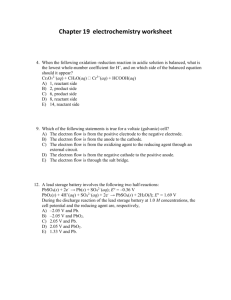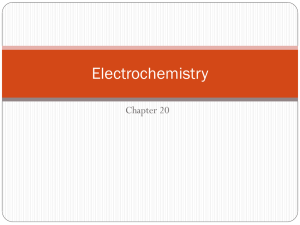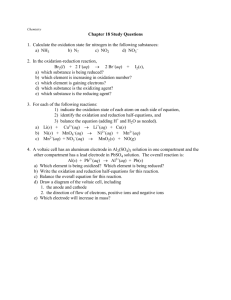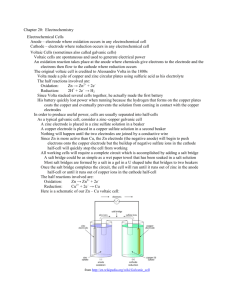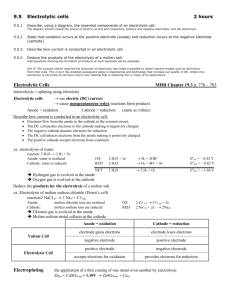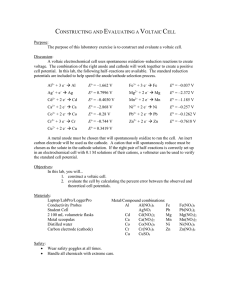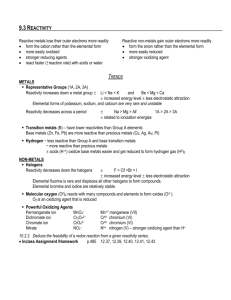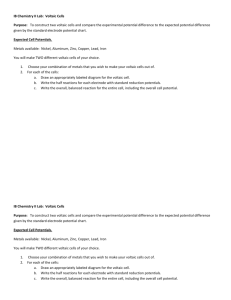Electrochemistry Worksheet
advertisement
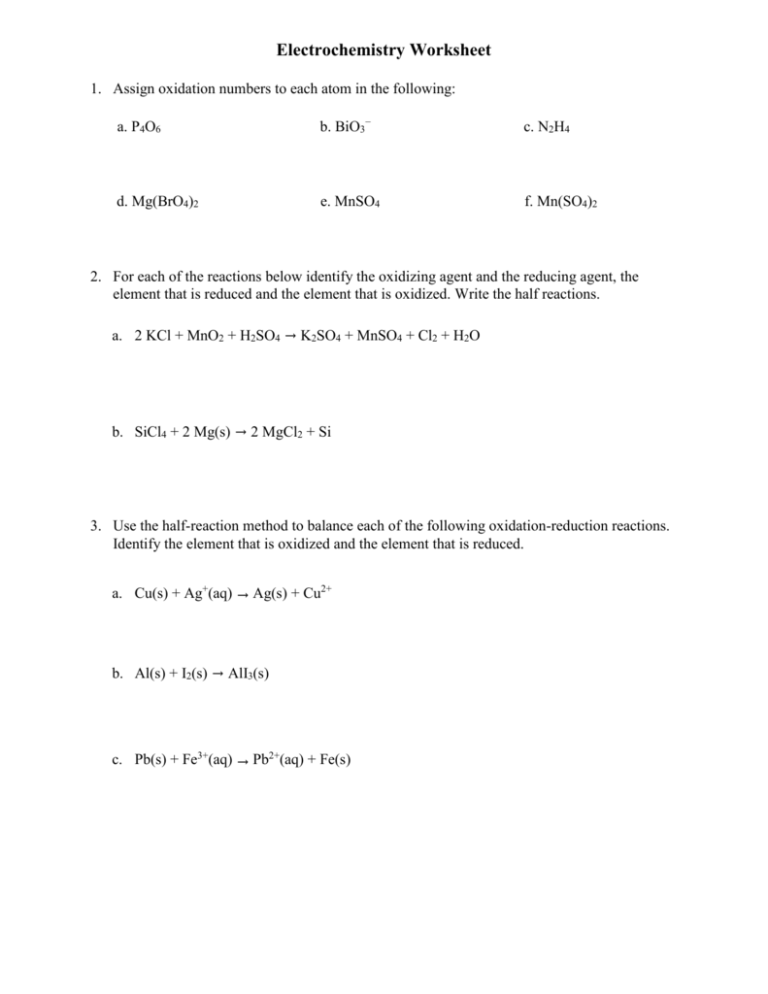
Electrochemistry Worksheet 1. Assign oxidation numbers to each atom in the following: a. P4O6 b. BiO3− c. N2H4 d. Mg(BrO4)2 e. MnSO4 f. Mn(SO4)2 2. For each of the reactions below identify the oxidizing agent and the reducing agent, the element that is reduced and the element that is oxidized. Write the half reactions. a. 2 KCl + MnO2 + H2SO4 → K2SO4 + MnSO4 + Cl2 + H2O b. SiCl4 + 2 Mg(s) → 2 MgCl2 + Si 3. Use the half-reaction method to balance each of the following oxidation-reduction reactions. Identify the element that is oxidized and the element that is reduced. a. Cu(s) + Ag+(aq) → Ag(s) + Cu2+ b. Al(s) + I2(s) → AlI3(s) c. Pb(s) + Fe3+(aq) → Pb2+(aq) + Fe(s) 4. Balance each of the following oxidation-reduction reactions. Identify the element that is oxidized and the element that is reduced. a) S2O32− + OCl− → Cl− + S4O62− in acid b) CH3OH + MnO4 → HCOO− + MnO2 c) NO3− + Zn → NH4+ + Zn2+ d) Br2 → Br− + BrO3− in base in acid in base 5. Write the cell notation for the voltaic cell that incorporates the following redox reaction. Mg(s) + Sn2+(aq) → Mg2+(aq) + Sn(s) 6. Answer the questions below regarding the voltaic cell drawn. NO3– K+ Cathode A 2+ A NO3– NO3– NO3– B Anode 3+ B NO3– NO3– a. Write both half-reactions: Cathode Half Reaction: Anode Half Reaction: b. In which direction will the electrons flow? c. In which direction will the NO3− ions flow in the salt bridge? d. Which electrode decreases in mass during the reaction? e. Write the cell notation for this voltaic cell. 7. Draw a voltaic cell that is constructed with a Mn/Mn2+ electrode and a Cd/Cd2+ electrode. Use the Standard Reduction Potential chart to determine which electrode will be the cathode and which will be the anode. Your drawing should include all of the following components: a. Label the location of each substance (Mn, Mn2+, Cd, and Cd2+) b. Label the cathode and the anode c. Label the direction of electron flow d. Include a salt bridge with NaNO3. Label the direction that each ion flows e. Write the cell notation for this voltaic cell. f. Calculate the cell potential of this cell. 8. Given the following half-reactions and half-cell potentials, write the balanced overall electrochemical reaction that would occur and calculate the cell potential of a voltaic cell incorporating these two half reactions. O2(g) + 2 H2O(l) + 4 e− → 4 OH−(aq) Cr3+(aq) + 3 e− → Cr(s) E° = +0.40 V E° = −0.74 V 9. Balance the following skeleton reaction, calculate E°cell, and determine whether the reaction would be spontaneous as written. You will need to the Standard Reduction Potential chart. Cr3+(aq) + Cu(s) → Cr(s) + Cu2+(aq) 10. Answer the question below regarding the reaction, Cl2(g) + Fe2+(aq) → Cl−(aq) + Fe3+(aq). a. Balance the reaction using the half-reaction method. (Note: no H’s or O’s) b. Use the Standard Reduction Potential chart to calculate the E°cell and determine whether this reaction would occur in a voltaic cell or an electrolytic cell. c. Use E°cell to calculate ∆G° for this reaction (the ° symbol denotes standard conditions; what temperature is standard conditions?) d. Use E°cell to calculate Kc for this reaction at 25 °C. 11. Answer the question below regarding the reaction, Pb2+(aq) + Ag(s) → Pb(s) + Ag+(aq). a. Balance the reaction using the half-reaction method. b. Use the Standard Reduction Potential chart to calculate the E°cell and determine whether this reaction would occur in a voltaic cell or an electrolytic cell. c. Use E°cell to calculate ∆G° for this reaction (the ° symbol denotes standard conditions; what temperature is standard conditions?) d. Use E°cell to calculate Kc for this reaction at 25 °C. 12. An aluminum electrode weighing 54.98 g is used in an electrolysis reaction using a current of 1.2 A. After the reaction is stopped, the aluminum electrode weighs 54.09 g. a. Did the aluminum electrode described above act as the cathode or the anode? b. How many hours was the current applied to the electrolysis cell? 13. How many grams of silver can form by passing 19.8 A through an electrolytic cell containing silver ions for 13.2 min? Model 1: Reduction Potentials The standard reduction potential, E0red has units of volts (V) and is a measure of a species ability to attract electrons. The more positive the reduction potential, the stronger is the attraction for electrons. Put another way, the more positive the reduction potential, the easier the reduction occurs. Some standard reduction potentials are given below. Reduction reaction E0red (V) (1) +0.80 Ag+(aq)+ e+Ag(s) ++ + (2) +0.34 Cu (aq)+ 2e Cu(s) ++ + (3) -0.14 Sn (aq)+ 2e Sn(s) ++ + (4) -0.76 Zn (aq)+ 2e Zn(s) Critical thinking questions 1. Which is a stronger oxidizing agent: Ag+ or Cu2+? Explain how you can tell in terms of the reduction potentials. 2. If reactions (1) and (2) are added together as a redox reaction which do you think will proceed as a reduction and which as an oxidation? (Hint: which one will reverse?) 3. Apply the same logic to reactions (3) and (4). Does it matter that they both have negative reduction potentials? Model 2: Voltaic Cells We can harness the electrical energy in a redox reaction, to make a battery, by setting up a voltaic cell. To do this, two half reactions are separated into compartments and electrodes are used to facilitate the electron transfer. The potentials for the two reactions are: Sn++(aq)+ 2e+Sn(s) E0red = -0.14 V Zn(s) Zn++(aq)+ 2e+ E0ox = +0.76 V This gives an overall voltmeter reading of: E0cell = E0ox + E0red = +0.62 V. Critical thinking questions 1. Explain why the Zn half reaction is proceeding as an oxidation and why +0.76 V is used as the potential for its half-cell instead of -0.76 V as in the table in Model 1? 2. Which electrode (Zn or Sn) will lose mass and which one will gain mass? 3. Does oxidation or reduction occur at the cathode? 4. Which of the following statements are correct? (a) (b) (c) (d) Electrons flow through the wire, towards the zinc electrode. Electrons flow through the wire, towards the tin electrode. Electrons flow through the salt bridge, towards the zinc electrode. Electrons flow through the salt bridge, towards the tin electrode. 5. The salt bridge contains Na+(aq) and SO42-(aq). Do these ions move when the cell is operating and, if so, in which direction(s)? 6. If an electrochemical cell with Ag and Cu electrodes was setup, what would be the two half reactions, which would be the cathode and which would be the anode, and what would be the standard cell potential? (Hint: use the standard reduction potentials in Model 1.) 7. If an electrochemical cell with Sn and Cu electrodes was setup, what would be the two half reactions, which would be the cathode and which would be the anode, and what would be the standard cell potential? 8. If an electrochemical cell with Sn and Zn electrodes was setup, what would be the two half reactions, which would be the cathode and which would be the anode, and what would be the standard cell potential? 9. Which combination of the half cells in Table 1 would make the highest voltage battery? (1) (2) (3) (4) 10. Reduction reaction Ag+(aq)+ e+Ag(s) Cu++(aq)+ 2e+Cu(s) Sn++(aq)+ 2e+Sn(s) Zn++(aq)+ 2e+Zn(s) E0red (V) +0.80 +0.34 -0.14 -0.76 Nicotine adenine dinucleotide (NAD) is involved in redox chemistry throughout the respiratory system. The reduced form of NAD is written as NADH and the oxidized form is written as NAD+. The standard reduction reaction and potential of NAD is given by: NAD+ + H+ + 2e- NADH E° = -0.105 V NAD is combined with each of the following reactions: (a) (b) CO2 + H+ + 2e- HCOO- E° = -0.20 V O2 + 4H+ + 4e- H2O E° = +0.82 V Write the overall reaction for each of the cells in the direction of spontaneous change. Is the NAD reduced or oxidized in these reactions?

